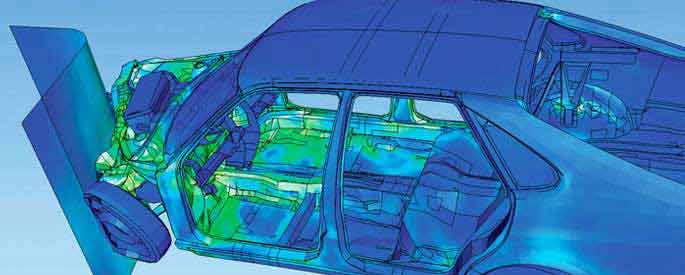Sources of Non-linearity
Posted by Bhaumik Dave on February 5th, 2014
A linear finite element analysis is performed when the structure is expected to behave linearly and obeys Hooke’s Law. The stress is always in proportional to the strain and the structure like a beam will return to its original configuration when the load is removed.
We can also apply superposition i.e., if you can run one analysis for a given load to calculate the displacement or stresses; you do not have to rerun the analysis for different loads.

You can just calculate or conclude the displacement or stresses from the first one as you are dealing with the linear function.
If any of the above conditions of math or if the stress level is greater than the yield strength of the material; we have couple of options:
- We can perform a non-linear analysis to determine the degree of the plastic behavior
- We can look for a better material or change the geometry to better manage the stress. This means to keep the stress always linear and this also means that the stress remains less than yield value.
The two solutions can be expensive because they involve changing or adding material.
Let us now look at the different sources of non-linearity:
- Geometric
- Material
- Contact
What are the general guidelines to use the non-linear analysis versus the linear analysis?
Basically all structural problems are non-linear in nature. Non-linear FEA is used to predict the behavior of the structure that is loaded beyond the elastic limit of the material. The structure experiences large deformation and will not return to its original shape.
Sometimes the linear analysis can be good approximation but most of the time used in simplified linear approximation may take less processing time; but also may yield wrong results. This can be dangerous especially when dealing with safety parts and equipments.
It is widely accepted that the three main sources of non-linearity are:
- Geometric: When you are dealing with large deflections, large displacements, pre-loads, instability and collapse. This means the stiffness varies as you resolve large geometric difference between the initial and the firm shape.
- Contact: Also called the non-linear boundary foundation. If two parts or more come into contact or interfere with each other then also this stiffness of the assembly will vary and change.
- Material Non linearity: This is when you are dealing with nonlinear material. When you are using nonlinear finite element then you are recommended to use nonlinear material. Whether you are dealing with plasticity, hyperelasticity, creep, viscoelasticity etc. The variation of the material among others in case of elasto-plastic material will call the stiffness of the structure to also change.


